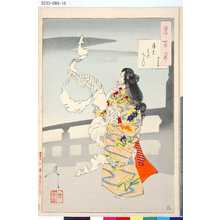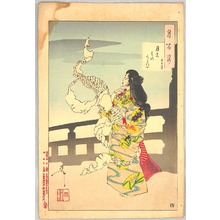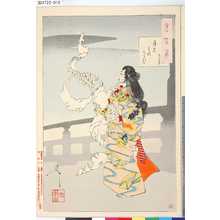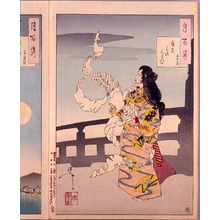月岡芳年による浮世絵「Tsuki no Monogurui- fumihiroge」
作者:月岡芳年
作品名:Tsuki no Monogurui- fumihiroge
制作年:1889
詳細:詳細情報...
情報源:Japanese Art Open Database
浮世絵(全 17,130 件)を表示...
説明:
Yoshitoshi Taiso, 1839-1892 From the series, "Tsuki Hyaku-shi" (One Hundred Aspects of the Moon) "Tsuki no Monogurui- fumihiroge" Ochiyo became mad when she heard of her lover's death. She walks on the Gojo Bridge rolling and unrolling the scroll which was sent from her lover. Format Oban tate-e Width 9.9 inches = 25.1 cm Height 14.7 inches = 37.3 cm Impression good ... blind printing on cartouche Colors good ... orange color oxidized Condition very good ... the upper area lightly rubbed, margins somewhat wrinkled Rating 2 = very good Yoshitoshi Taiso 1839-1892 Yoshitoshi lived during a period of incredible turmoil and upheaval in Japan. After the forced opening of the country by a US fleet, the country underwent an often bloody transition from the classical Shogunate to modern Japan. Yoshitoshi's personal life was like an analogy of this difficult era. The struggle for survival in a new world and the constant fight between tradition and westernization characterised his life. Yoshitoshi's work represents the traditional Japanese values. He is considered as one of the greatests artists of the Meiji Period. Yoshitoshi in His Early Years The given name of Yoshitoshi was Yonejiro. We do not know much about his youth. But all indications are that it was not a very pleasant one. His father had taken a mistress and the boy was apparently unwanted. He was brought up by his uncle. At the age of eleven, Yoshitoshi was enrolled as a student of the school of Kuniyoshi, the great artist of ukiyo-e. One of his school class mates was Yoshiiku. Yoshiiku bullied the younger Yoshitoshi. The rivalry and hostility between both should continue for the rest of their lives. At the age of fourteen, Yoshitoshi composed his first woodblock print - a triptych of the naval battle of Dannoura in which the Minamoto clan destroyed the forces of the Taira clan in 1185. The same year, in 1853, US Commodore Perry arrived with a fleet of naval battle ships and forced the opening of Japan to the West. Tough Times for Yoshitoshi and Bloody Prints from 24 Accomplishments Kuniyoshi was like a father towards Yoshitoshi. When Kuniyoshi died in 1861, hard times were ahead of the young student. He hardly had enough commissions to survive. The early sixties were a period of great unrest and civil war-like skirmishes between proponents of the old Shogun government and their opponents who gathered around the emperor. During the Shogunate, that is since 1192, the Japanese Emperors had been powerless. In addition to the political instability, a devastated economy made things worse for ordinary citizens. Japan was then in a deep recession, plagued by hyper inflation and by crop failures. In 1868 the last Shogun resigned after 2000 men of his troops were badly defeated by an imperial force in the bloody battle of Ueno. It was more of a massacre than a battle. The imperial soldiers were well-equipped with modern guns while their enemies fought with swords. Yoshitoshi eye-witnessed this battle. Immediately after this battle and later in his life, Yoshitoshi composed many prints with extremely bloody and gruesome scenes - often with a black background. Certainly, these prints must be seen in connection with the events that took place in these years of upheaval. Besides, the publishing of ukiyo-e prints was always driven by the thrive for commercial success. And not much different from today's tabloid press, themes with blood, sex and crime sold well. Yoshitoshi During the Meiji Restoration New Thirty Six Ghost Stories With the Meiji Restoration, Yoshitoshi experienced a short period of modest commercial success followed by a sharp decline in commissions and bitter poverty. In the early seventies his problems with mental illness and depression erupted. Unable to work, he hardly produced any prints for two years. In 1873 he recovered from his depressions and changed his name to Taiso, which means "great resurrection". But in spite of new energies, his poverty continued. Yoshitoshi had to experience embarrassing moments. Okoto, his mistress sold herself to a brothel to raise money for Yoshitoshi's support. Okoto shared the fate of many wives of impoverished former Samurai who could not support their families. After the end of the Shogunate the privileges that this warrior class had enjoyed for centuries, were abolished The Satsuma Rebellion Customs and Manners In 1877 the political events changed Yoshitoshi's life again. This time it was in his favor. An uprise of the samurai class came to its final climax. The Samurai were lead by Saigo Takamori. The imperial troops pushed them back. In the final battle of Satsuma, 60,000 government troops faced 40,000 rebels. The rebels were completely crushed in a huge bloody battle. The casualty rate was more than 50% percent among the samurai rebels. 2,000 more were executed later. In the aftermath of this rebellion, there was a huge demand for illustrations of the events and Yoshitoshi was literally flooded with commissions. Yoshitoshi - Late Success and Recognition One Hunderd Aspects of the Moon In the eighties, Yoshitoshi was finally financially settled. He moved into a huge house of his own and married a woman from the pleasure quarters. His school flourished. In 1882 he was employed by a newspaper. This gave him a steady income and marked the end of long years of poverty and sufferings. Yoshitoshi's reputation grew, and in spite of his bad health he unrelentlessly composed a great number of prints. These years were Yoshitoshi's most prolific ones - not only in terms of quantity, but also in terms of artistic quality. In 1995 the first designs of One Hundred Aspects of the Moon was published. This series was extremely popular. People waited in long lines to get one of the coveted copies of a new design. In 1888 the series 32 Aspects of Customs and Manners was published - a series of women prints. In 1889 a new series with ghost subjects came on the market: New Form of 36 Ghosts. Yoshitoshi firmly believed in the existence of ghosts. He was convinced of having experienced by himself some personal encounters with supernatural appearances. The symptoms of mental illness became more and more frequent. Nevertheless Yoshitoshi continued to work. He died on June 9, 1892 from a cerebral hermorrhage at the age of 53.











